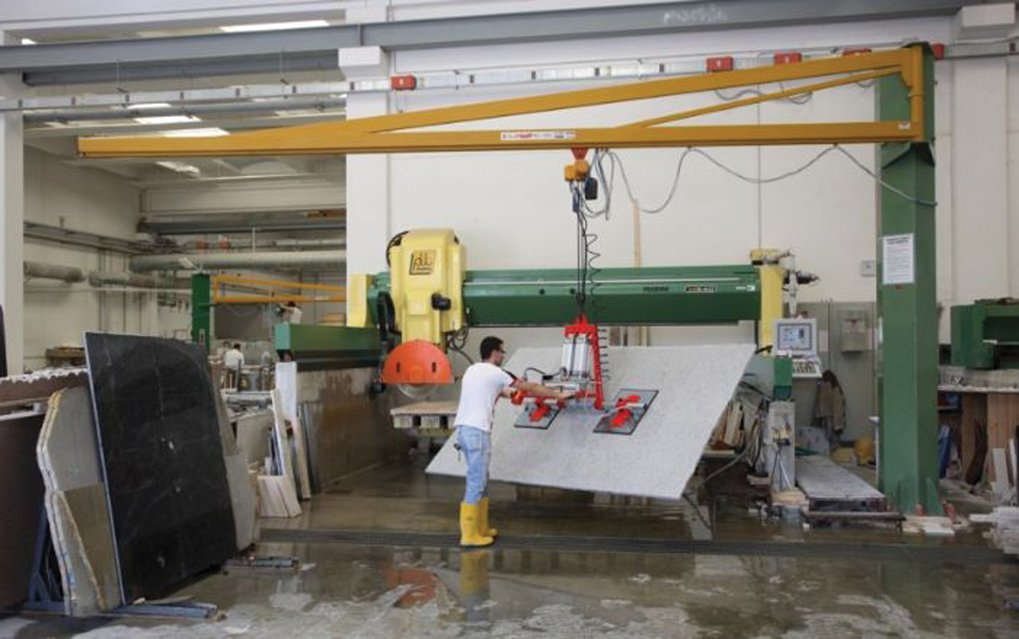Small investments that improve the flow of materials into, through and out of your premises can improve your productivity, staff retention, health & safety record and reputation. And that shows up on your bottom line.
If there is one thing life teaches us it is the importance of having the right tools for the job. That’s as true for moving work around a factory or workshop or handling it onsite as it is for cutting, shaping and polishing a piece of stone.
Manhandling heavy pieces of stone not only takes a progressive toll on backs and joints, it can lead to acute injuries such as cuts, crush injuries and pulled muscles. Sometimes even worse.
And improving handling is not even just about making life less painful, it also reduces the risk of damaging work, both in progress and finished, and can considerably improve productivity, with the benefit that has for the bottom line.
As if that were not already reason enough for taking a second look at how materials enter your premises, progress through them, leave them and get installed on site, there is the additional benefit of satisfying the Health & Safety Executive (HSE).
HSE inspectors are happy enough to bill you for the benefit of their written guidance and might even stop you working if they don’t like the way you are doing it. The HSE website includes plenty of advice for improving the way you handle heavy materials as well as tools to help you assess the risks.
There is the MAC tool and the V-MAC tool to help analyse lifting, carrying and handling operations; the ART tool, for repetitive upper limb tasks; the RAPP tool for pushing and pulling. You might find it useful to use more than one of these tools for any particular operation. To find out more from HSE take a look at: www.hse.gov.uk/msd.
The ‘MSD’ in the URL above refers to ‘musculoskeletal disorders’, a term that encompasses any injury, damage or disorder of the joints or other tissues in your limbs or back.
The government’s Labour Force Survey shows that MSD cases, including those caused by manual handling, account for more than a third of all work-related illnesses reported each year to the enforcing authorities. When you add in slips, trips and falls, which are often a result of poor handling and general housekeeping, that rises to 40% of all non-fatal injuries and even 2% of fatal injuries.
Apart from the tragedy of a death or life-changing injury, that is a lot of working days lost. Typically, MSD injuries result in a week off work – and in the past three years there were an average of 4.3million working days lost each year as a result of non-fatal workplace injuries.
The Manual Handling Operations Regulations 1992 (MHOR) require companies to manage and minimise the risks their employees are exposed to. They must:
- Avoid hazardous manual handling operations (so far as is reasonably practicable) by redesigning the task to avoid moving the load or by automating or mechanising the process
- Make a suitable and sufficient assessment of the risk of injury from any hazardous manual handling operations that cannot be avoided
- Reduce the risk of injury from those operations so far as is reasonably practicable.
- Where possible, provide mechanical assistance – for example, a sack trolley or hoist. Where this is not reasonably practicable explore changes to the task, the load and the working environment.
The weight of what is being moved is a factor in the risk associated with manhandling it, but other factors are also involved: for example the number of times you have to pick up or carry an item; the distance you are carrying it; where you are picking it up from and what you are putting it down on to (eg picking it up from the floor and putting it on a shelf above shoulder level).
And as most of us have painfully discovered from time to time, twisting, bending, stretching or any other awkward posture can also lead to injury.
Fortunately, there are more tools than ever to help stone companies handle everything from raw materials to finished products more safely, with less effort and with less danger of damaging the materials being moved. They are affordable, well made and often even pleasingly ingenious, so they get used with enthusiasm, not reluctance.
Materials handling products are sold in the UK and Ireland by some of the major machinery suppliers – D Zambelis, LPE Group, Stone Equipment International, the Waters Group, Stonegate…
There are other suppliers, but just a note of caution: there have been some products offered lately claiming safety certificates and CE marks that have no testing or certificates to back up the claims, so you might like to ask to see verification if you have any doubts.
Hopefully, the brands of some of the products are already familiar. They include Aardwolf, Weha, Elephant, Deltarack, Gorilla, Dal Forno, Asinus and more.
One of the latest brands to join the line-up is Omni Cubed, which is another American company Carl Sharkey and Simon Bradbury at LPE Group are creating a distribution network for across Europe, including the UK.
The LPE Group has now grown to the point where it needs individuals to head sales for the various parts of the business, and Ash Butler has been recruited to manage sales of Omni Cubed. (There will be more about the developments at LPE Group in the next issue of Natural Stone Specialist.)
He will also be selling Manzelli vacuum lifts, which is the latest marque added to the LPE product range. It includes the new Evolution range with push-fit vacuum connectors and easy use rotation pads.
The Pro-Lift is the flagship product for Omni Cubed. Ash says its having “a titanic impact for those customers who are proactively managing their health & safety”. And that is not just the big players. “A growing number of smaller fabricators / fitters are seeing the value of the Pro-Lift because it effectively becomes another member of the team.
“It’s all aircraft-grade aluminium, which means although it’s lightweight, it’s powerfully strong, nimble and manoeuvrable. It can lift a full slab up to 450kg with ease. Only this week on a site demo a customer used it to unload a 400kg L-shaped island which was laying flat on the floor of a flatbed van. It took two fitters, a Pro-Lift and a pair of our robust Aqua Jaw clamps. It’s not surprising it has to be seen to be believed – if we just told people this they’d think we were bluffing!”
Then there’s the Stealth Steamer 90, developed in response to customer feedback. Set to a true 90º angle, it is a development of the standard Stealth Steamer (for pulling joints together) for installing end panels / downstands for kitchen islands, although it is also extremely useful for shower cladding, pulling backsplashes into a worktop, and even pulling together upright panels of a column.
D Zambelis has added the already established Dal Forno range of lifting and materials handling products to its offering. It showed a Dal Forno vacuum lift on its stand at the Natural Stone Show in London this year and Stella Zambelis says a range of the brand’s products will be on the D Zambelis website soon.
As well as the vacuum lifts, Dal Forno makes jib (or pillar) cranes, overhead cranes and electric chain hoists.
Stone Equipment International is a worldwide supplier of new and used stone machinery that also offers lifting and handling equipment from Elephant, an Italian company that offers a world class range of lifting and handling equipment designed specifically for the stone industry.
Elephant and Stone Equipment International make the point that you don’t have to be a large company to benefit from improving your handling. Just about all stone companies can benefit from improvements to the way they handle their stone, at their yards and onsite.
Stone Equipment International also sells a range of Weha materials handling equipment. The Weha range is extensive and supplied by other companies as well.
One of the latest innovations from Weha is a vacuum lift specifically for use with large format slabs of thin ceramics (even those with textured surfaces) that can prove irritatingly prone to crack and split.
The newly developed T400 Ceramic has five relocatable crossbars, each with three suction pads, to give optimum loading distribution evenly across the slab. Loads of up to 400kg can be lifted.
Using the T400, you can manoeuvre large format thin porcelains from stock directly on to a bridge saw positioning it using a pneumatic cylinder that turns through a maximum of 90°. A built-in ejector requires 120litres of air per minute. The operating pressure is 5-6bar (500-600kPa).
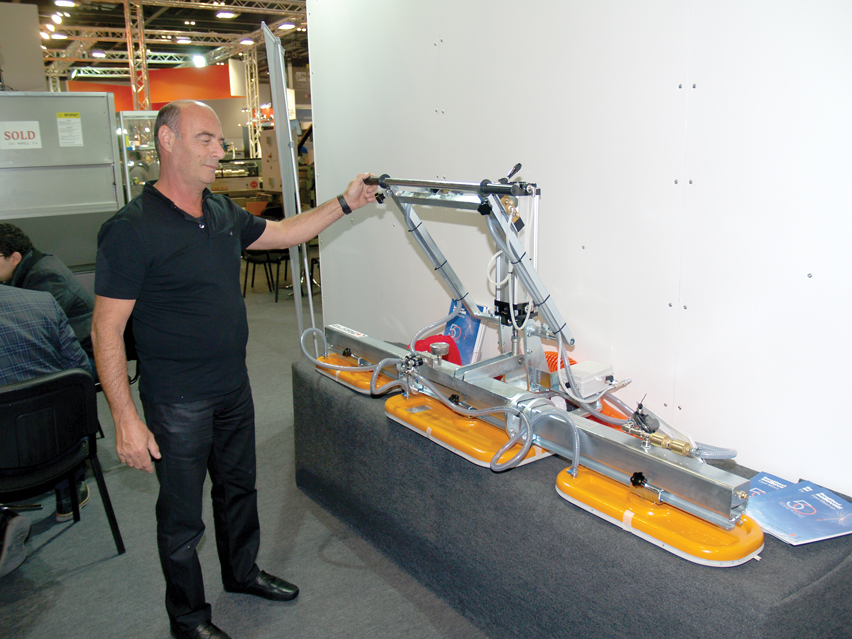
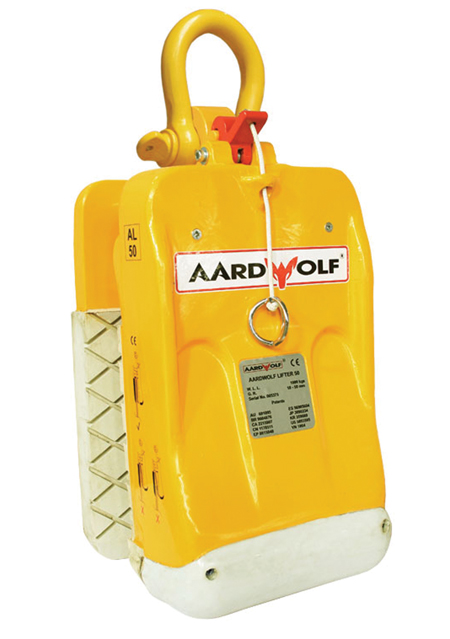 D Zambelis has taken on the sale of Dal Forno lifting and handling equipment, including vacuum lifts like the one Dimitri Zambelis is pictured with here on the D Zambelis stand at the Natural Stone Show in London this year. Zambelis also stocks the Aardwolf and Abacus brands. Latest from Abacus are 90º clamps for clamping mitred right angles.
D Zambelis has taken on the sale of Dal Forno lifting and handling equipment, including vacuum lifts like the one Dimitri Zambelis is pictured with here on the D Zambelis stand at the Natural Stone Show in London this year. Zambelis also stocks the Aardwolf and Abacus brands. Latest from Abacus are 90º clamps for clamping mitred right angles.

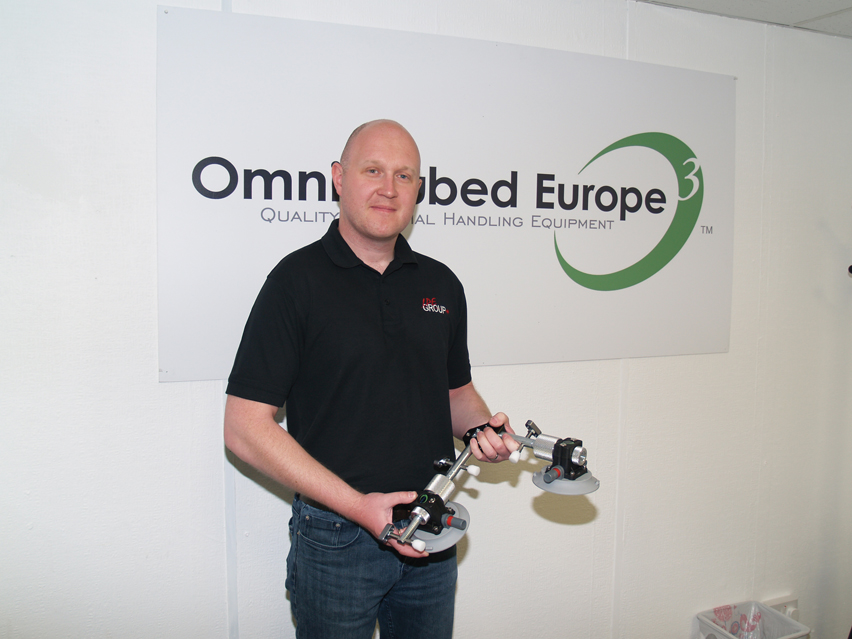
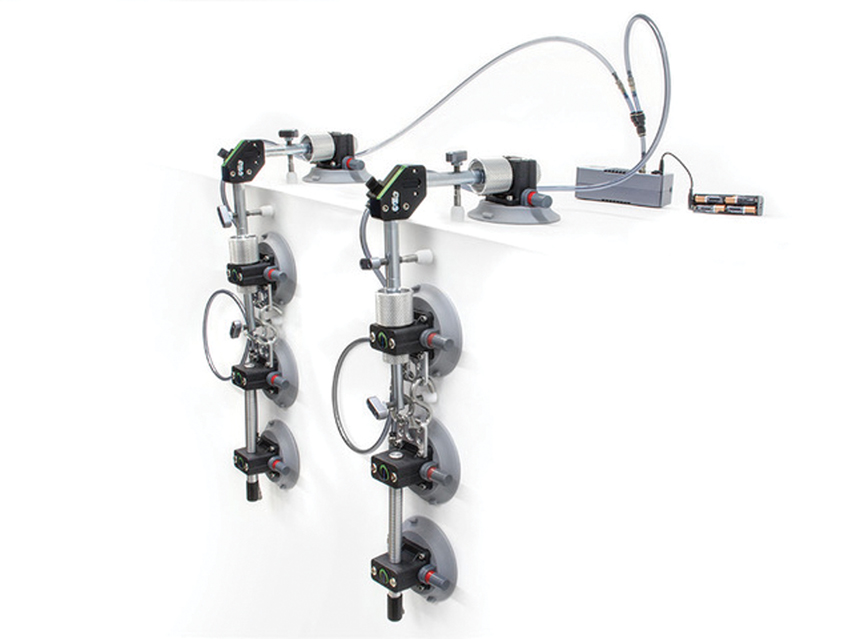 Ash Butler, who is heading sales of the Omni Cubed range from LPE Group. Pictured here are the Omni Cubed Stealth Steamer 90, the Pro Lift and the Pro Cart.
Ash Butler, who is heading sales of the Omni Cubed range from LPE Group. Pictured here are the Omni Cubed Stealth Steamer 90, the Pro Lift and the Pro Cart.
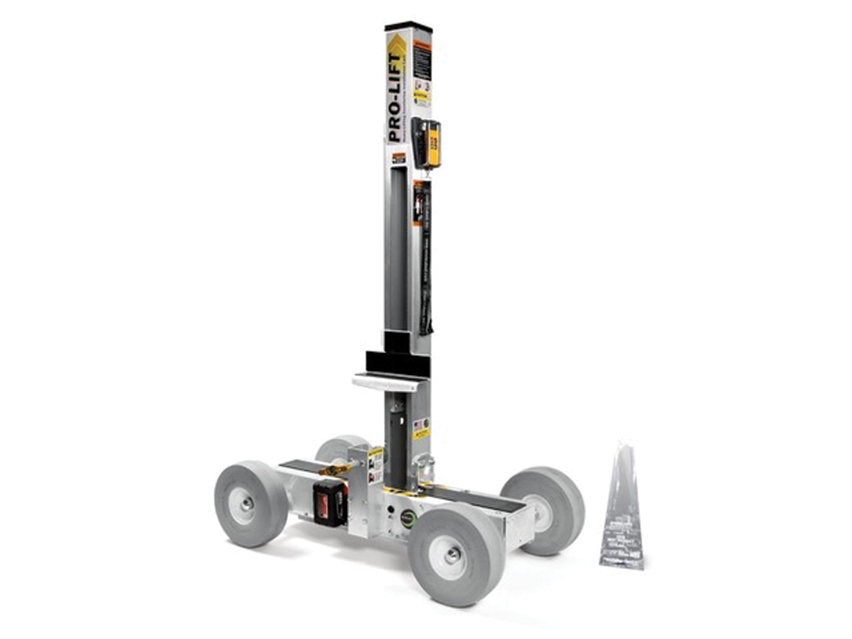
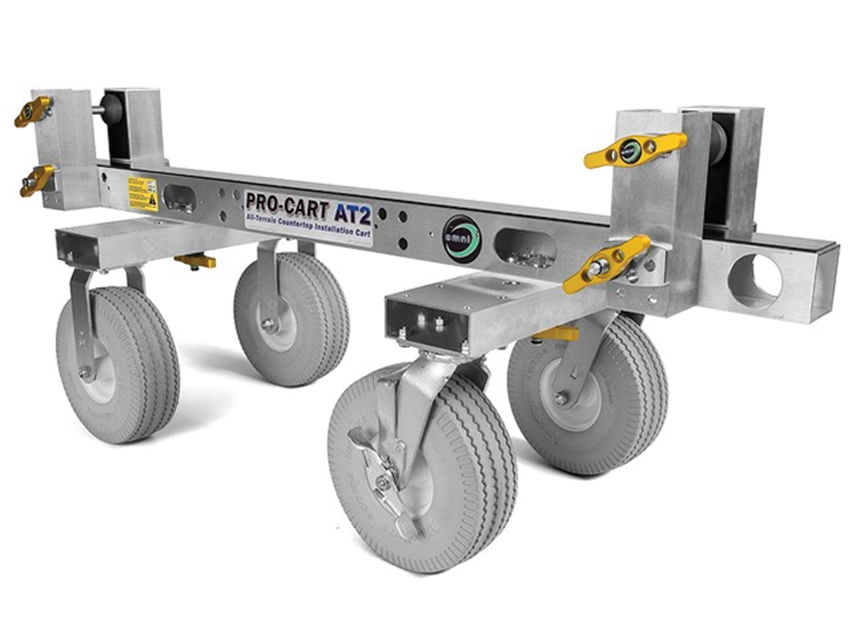
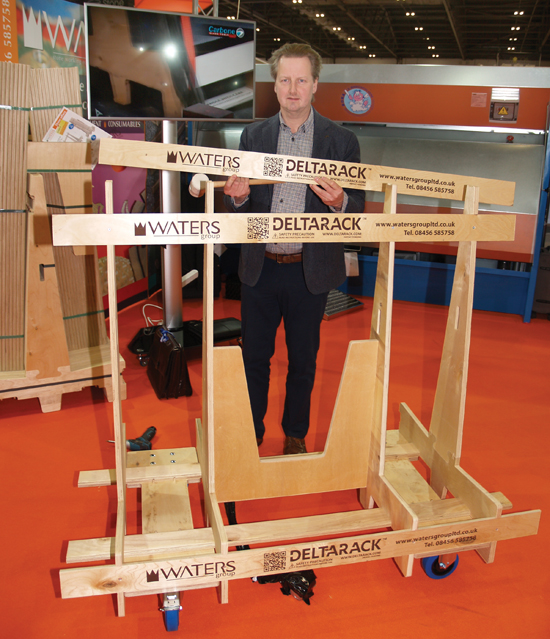
Jan Servaes from Deltarack pictured on the Waters Group stand at the Natural Stone Show in London this year where he demonstrated the new Deltarack plywood wheeled ‘A’ frame that Waters is selling in the UK and Ireland. Intended as a semi-disposable aid to handling, the frames are supplied six at a time as flat-packs for less than £100 each. They are easily and quickly assembled using nothing more than a soft mallet and a screwdriver – and there are only eight screws in each frame. It takes about two minutes to assemble one. Jan, whose background is in the stone industry, says he made the ‘A’ frame for his own use, but customers kept asking him if he could make them one, so he developed it into a product. It was introduced to the Waters Group by König. Waters supplies a wide range of products for stone companies including various handling aids, one of which is the König Asinus electric lift trolly.
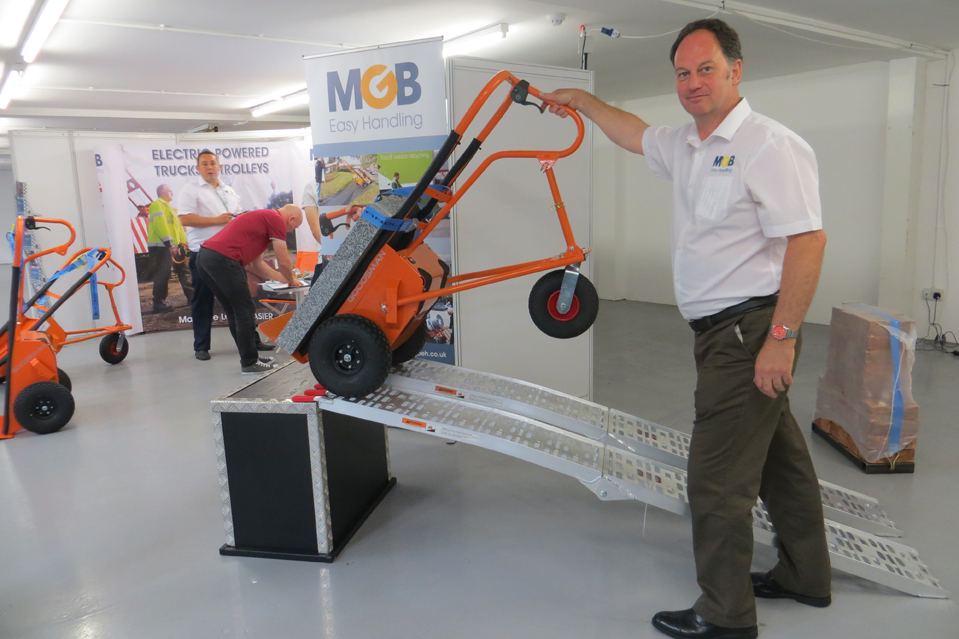 The stone industry has proved to be so good for MGB Easy Handling since it launched its electric sack truck at the NAMM Tradex memorial masonry exhibition in 2015 that it has modified its product to produce a truck specifically for the stone sector with larger wheels (12in / 300mm), a third wheel, a lower toe blade, and an 8º backwards lean. It exhibited what it now calls the 300 Mason Truck (the 300 denotes its capacity to carry 300kg) at the Natural Stone Show in London, where it proved particularly popular among masons in the heritage sector, and again at this year’s NAMM Tradex in Leamington Spa. It is pictured here at Tradex being demonstrated by Mark Bridges, who designed it and whose company makes it. He was running it up and down the slope to show how well it climbs and how long the battery lasts. “It always surprises people,” he told NSS.
The stone industry has proved to be so good for MGB Easy Handling since it launched its electric sack truck at the NAMM Tradex memorial masonry exhibition in 2015 that it has modified its product to produce a truck specifically for the stone sector with larger wheels (12in / 300mm), a third wheel, a lower toe blade, and an 8º backwards lean. It exhibited what it now calls the 300 Mason Truck (the 300 denotes its capacity to carry 300kg) at the Natural Stone Show in London, where it proved particularly popular among masons in the heritage sector, and again at this year’s NAMM Tradex in Leamington Spa. It is pictured here at Tradex being demonstrated by Mark Bridges, who designed it and whose company makes it. He was running it up and down the slope to show how well it climbs and how long the battery lasts. “It always surprises people,” he told NSS.

